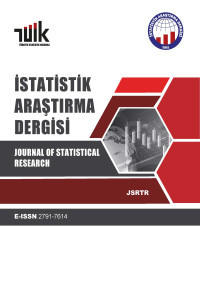Mevsimsel Düzeltme için ARIMA Model Tabanlı Yaklaşım
ARIMA model, Kanonikal ayrıştırma, Sinyal çıkarımı, Spektrum, Wiener-Kolmogrov filtresi
An ARIMA-Model-Based Approach to Seasonal Adjustment
ARIMA model, Canonical decomposition, Signal extraction, Spectrum, Wiener- Kolmogrov filter,
___
- Alper C.E., and Bora S., 2004. Moving holidays and seasonal adjustment: The case of Turkey. Review of Middle East Economics and Finance, Volume: 2 , Issue: 3 , Pages: 203-209.
- Bell, W.R., 1984. Signal extraction for nonstationary time series. The Annals of Statistics, 12, 2, 646-664.
- Bell W.R., and Hillmer, S.C., 1984. Issues involved with the seasonal adjustment of economic time series. Journal of Business and Economic Statistics, 2, 291-320.
- Box, G.E.P and Jenkins, G.M., 1970. Time series analysis: Forecasting and control. San Francisco, Holden Day.
- Box, G.E.P, Hillmer S.C., and Tiao G.C., 1978. Analysis and modeling of seasonal time series, in seasonal analysis of time series. ed. A. Zellner, Washington, D.C. U.S.Department of Commerce, Bureau of the Census, 309-334.
- Box, G.E.P., and Tiao, G.C., 1975. Intervention analysis with applications to economic and environmental problems. Journal of the American Statistical Association, 70, 71-79.
- Box, G.E.P. and Pierce, David A., 1970. Distribution of residual autocorrelations in autoregressive-integrated moving average time series models. Journal of American Statistical Association, 65 (December), 1509-1526.
- Burman, J.P., 1980. Seasonal adjustment by signal extraction. Journal of the Royal Statistical Society, Ser. A, 143, 321-337.
- Chen C. and Liu L. M., 1993. Joint estimation of model parameters and outlier effects in time series. Journal of the American Statistical Association, 88, 284-297.
- Chang, I., Tiao, G.C., and Chen, C., 1988. Estimation of time series models in the presence of outliers. Technometrics, 30, 2, 193-204.
- Findley, D.F., Monsell, B.C, Bell, W.R., Otto, M.C. and Chen, S., 1998. New capabilities and methods of the X-12 ARIMA seasonal adjustment program (with discussion). Journal of Business and Economics Statistics, 16, 127-177.
- Gómez, V., Maravall, A. and Peña, D., 1999. Missing observations in ARIMA models: skipping approach versus additive outlier approach. Journal of Econometrics, 88, 341-364.
- Gómez, V. and Maravall, A., 2001a. Automatic modelling methods for univariate series, Ch.7 in Peña D., Tiao G.C. and Tsay, R.S. (eds.) A Course in Time Series Analysis. New York: J. Wiley and Sons.
- Hannan, E.J., 1980. The estimation of the order of ARMA processes. Annals of Statistics, 8, 1071-1081.
- Hillmer, S.C., 1985. Measures of variability for model-based seasonal adjustment procedures. Journal of Business and Economic Statistics, 3, 1, 60-68.
- Hillmer S.C., and Tiao G.C., 1982. An ARIMA-model-based approach to seasonal adjustment. Journal of the American Statistical Association, 77, 63-70.
- Hillmer, S.C., Bell, W.R. and Tiao, G.C., 1983. Modeling considerations in the seasonal adjustment of economic time series. in Zellner, A. (ed.), Applied time series analysis of economic data, Washington, D.C.. U.S. Department of Commerce. Bureau of the Census, 74-100.
- Ljung, G. and Box G.E.P., 1978. On a measure of lack of fit in time series models. Biometrika, 65, 297-303.
- Maravall, A., 1987. On minimum mean squared error estimation of the noise in unobserved component models. Journal of Business and Economic Statistics, 5, 115-120.
- Maravall, A., 1995. Unobserved components in economic time series, in handbook of applied econometrics. (eds) Pesaran, M. H., and Wickens, Blackwell, Oxford.
- Maravall, A. and Planas, C., 1999. Estimation error and the specification of unobserved component models. Journal of Econometrics, 92, 2, 325-353.
- Nerlove, M., Grether, D.M, and Carvalho, J.L., 1979. Analysis of economic time series: A synthesis. New York, Academic Press.
- Pierce, D.A., 1978. Seasonal adjustment when both deterministic and stochastic seasonality are present. in seasonal analysis of economic time series. ed. A. Zellner, Washington, D.C.. U.S. Dept. of Commerce, Bureau of the Census, 242-269.
- Pierce, D.A., 1979. Signal extraction error in nonstationary time series. Annals of Statistics, 7, 1303-1320.
- Pierce, D.A., 1980. Data revisions in moving average seasonal adjustment procedures. Journal of Econometrics, 14, 1, 95-114.
- Phillips, P.C.B., Perron, P., 1988. Testing for unit roots in time series regression. Biometrika, 75, 335-346.
- Priestley, M.B., 1981. Spectral analysis and time series. New York, Academic Press.
- Sneek, M., 1984. Modelling procedures for economic time series. Amsterdam, Free University Press.
- Whittle P., 1963. Prediction and regulation using least-square methods. London, English Universities Press.
- ISSN: 1303-6319
- Başlangıç: 2002
- Yayıncı: TÜİK
Hizmet Sektöründe Mali Başarısızlığın Modellenmesi
Özlem İLK, Murat ÇİNKO, Deniz AKINÇ, Didem PEKKURNAZ
Mevsimsel Düzeltme için ARIMA Model Tabanlı Yaklaşım
Yapısal Bağımlılık Altında Karmaşık MAPK Yolunun Bayesci Tahmini
Özlem GÜRÜNLÜ ALMA, Serdar KURT, Aybars UĞUR
Güçlü İkili Kovaryans Tahmincisinin Performans Değerlendirmesi
Kardeş Cinsiyet Bileşiminin Eğitimsel Erişimlere Etkisi
Açıklayıcı ve Doğrulayıcı Faktör Analizlerinin Karşılaştırılması: Bir Uygulama
